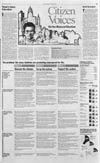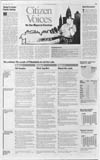Fall 1999
Philadelphia Inquirer Gives Voters a Voice and WPVI-TV Gets a Debate Ratings Hit
By Pat Ford
Pew Center

Sidney Toombs had been preparing for this moment for months. It was May 8, the final televised debate of the hotly contested Democratic Mayoral Primary in Philadelphia.
All five candidates were there. Toombs and other voters taking part in The Philadelphia Inquirer’s “Citizen Voices” project would be asking the questions – not newspaper or television reporters.
Toombs and several hundred other people had been meeting since January to zero in on the issues they considered pressing, to frame those issues and, in a full day of discussion, to devise the questions they would put to the candidates.
Toombs knew what he wanted to find out when he faced candidate Marty Weinberg. “Our group couldn’t agree on which is the bigger problem in Philadelphia schools: Not enough funding or mismanagement of the dollars available. Which do you think is the bigger issue and how would you address it?”
“Education is the single issue that crosses (political) lines,” Weinberg began, launching into his standard response but ignoring the question.
When Weinberg finished, the moderator turned to Toombs: “Does that answer your question?”
“Not really,” Toombs replied.
And there was an awkward pause.
Toombs was not a political reporter. He was a voter. Dodging his question did not look shrewd. It looked … bad.
The Inquirer’s Chris Satullo, deputy editorial-page editor, was watching the other candidates, who were off camera. They eyed each other a little nervously. It seemed to be dawning on them, he recalls, that answering questions from the citizens of “Citizen Voices” was going to be a new experience.

“Citizen Voices” is a project of The Inquirer’s editorial board designed to give voters a voice in the paper’s election coverage. In an editorial introducing the project last December, Satullo wrote, “Whatever commentary we do in this mayor’s race, we want to base it upon careful listening to the people of Philadelphia.”
Indeed, confides Editorial Page Editor Jane Eisner, with an editorial board made up mostly of suburbanites, she felt an obligation to give city voters a major voice in the paper’s commentary on the contest.
The Inquirer has used this technique before. During the 1996 congressional races and the 1997 New Jersey Governor’s race, the paper empaneled 100 to 200 citizens to focus its news commentary on election issues. In the governor’s race, the first statewide televised debate featured “Citizen Voices” participants asking questions they’d drafted in earlier sessions.
This time, The Inquirer joined with the University of Pennsylvania’s Annenberg School for Communication to recruit a demographically representative sample of voters to round out the somewhat elite group recruited through the editorial page. Together, they assembled the names of more than 700 voters; about 500 attended at least one activity.
In January, the paper held a series of neighborhood meetings for the participants to compose a list of issues most important to the city’s future. The five issues that emerged were: education, jobs, public safety, government reform and the quality of life in the city’s neighborhoods.
In February, the citizens met again, this time in four larger groups, to construct a framework for discussing each issue in a non-partisan way. Then in April, the entire group was invited to meet at the Annenberg School to develop questions on each issue for the candidates in the Democratic Primary. (The Republican primary was uncontested.)
More than 200 citizens attended. They analyzed and compared the candidates’ positions on issues and worked out the phrasing of questions they would put to candidates in a televised debate. “That was a truly wonderful day,” Satullo says.
Citizens who participated agreed. “I was amazed by how respectful everyone was of each other,” says Darcell Caldwell. “Even if they disagreed, they listened to each other and there were no fisticuffs. I thought, ‘this is like an idealized world’.”
“One Person at a Time”
The Inquirer didn’t cover these activities in its news pages. Satullo says the paper wanted to avoid what he calls “one of the great flaws of early civic journalism projects” -the assumption that because the paper held a meeting and citizens came, they were actually making news.

“I’d rather reporters come and just listen to learn what matters to voters,” says Satullo, “rather than worrying about writing a 15-inch story and wondering whether there’s a conflict of interest because the paper convened the meeting.”
Reporters and editors did attend the sessions to listen and meet people. But city editor Marc Duvoisin says it didn’t seem necessary to write news stories about it. “It was amply covered on the opinion pages,” says Duvoisin. “It would have been overkill (to write news stories about it).”
The editorial board used “Citizen Voices” as the chief tool for covering the mayor’s race. Citizen essays ran regularly on the Op-Ed page, as did candidates’ answers to citizens’ questions.
Philadelphia’s public radio station, WHYY-FM, broadcast parts of the April forum. The “Citizen Voices” debate aired on the city’s leading television news station, ABC affiliate WPVI-TV. It was the highest-rated show for its hour, reaching about 250,000 households.
Annenberg School Dean Kathleen Hall Jamieson would have liked the group to have a bit higher profile. Annenberg is studying the group as part of a larger research project. Jamieson says “Citizen Voices” didn’t generate enough media attention to have an impact on large numbers of people. “You can’t change society one person at a time,” Jamieson asserts.
Satullo says the purpose of “Citizen Voices” was to inform The Inquirer’s editorial coverage of the election, which it has done. Interviews with several of the participants, however, show there was change at the “one person at a time” level.
Feeling Empowered
“It’s one of the few times I’ve had even the smallest sense of feeling empowered,” says Caldwell. “It was one of the few times in my life that I felt like a true citizen.”
“It’s a chance to make a real difference without being one of the moneyed interests that most politicians listen to,” said participant Eric Schopf. “We got our ideas into the debate. We said, ‘Here’s what we want to talk about. Here are our concerns.’ And the candidates responded. It was a tremendous opportunity.”
Toombs says he feels his attitude toward public involvement has been fundamentally changed.
One moment of “Citizen Voices” stuck with Toombs. That was when a participant asked Satullo what was going to happen to “Citizen Voices” after the November election.
As Toombs recalls it, Satullo said: “The Inquirer has its place. But for ‘Citizen Voices’ to have resonance, it has to be run by citizens.”
That was the moment, Toombs says, he realized what a responsibility citizenship is. “It spoke to the nature of how we are, how we should be, how we could be as people, as citizens,” he says. “I keep coming back to that and thinking: What am I going to do next? How do I keep things moving in a positive direction?”
“Citizen Voices” will continue through the general election in November. Then, it will present to the new mayor and city council a “Citizens’ Agenda,” based on the group’s deliberations, Satullo says.
“The Citizens’ Agenda,” wrote Satullo in an editorial, “could be a to-do list for 21st Century Philadelphia, not just about what politicians should do, but what citizens should do for themselves and their city.”
